- Revenue Cycle Management
- COVID-19
- Reimbursement
- Diabetes Awareness Month
- Risk Management
- Patient Retention
- Staffing
- Medical Economics® 100th Anniversary
- Coding and documentation
- Business of Endocrinology
- Telehealth
- Physicians Financial News
- Cybersecurity
- Cardiovascular Clinical Consult
- Locum Tenens, brought to you by LocumLife®
- Weight Management
- Business of Women's Health
- Practice Efficiency
- Finance and Wealth
- EHRs
- Remote Patient Monitoring
- Sponsored Webinars
- Medical Technology
- Billing and collections
- Acute Pain Management
- Exclusive Content
- Value-based Care
- Business of Pediatrics
- Concierge Medicine 2.0 by Castle Connolly Private Health Partners
- Practice Growth
- Concierge Medicine
- Business of Cardiology
- Implementing the Topcon Ocular Telehealth Platform
- Malpractice
- Influenza
- Sexual Health
- Chronic Conditions
- Technology
- Legal and Policy
- Money
- Opinion
- Vaccines
- Practice Management
- Patient Relations
- Careers
Culture in Amsterdam and Basel
Small cities Amsterdam and Basel are full of culture and history with dozens of museums and plenty of public transportation to make getting around easy.
Photos by Thomas and Shirley Mueller
As part of our seven-day cruise down the Rhine River, I made time to explore the cities at the beginning and end of the trip: Amsterdam and Basel. Before taking the Viking Cruise, I had no idea if I would like it or not and didn’t want to entrust any more time or money with the cruise line in case it wasn’t what I expected. So instead of going with Viking’s options in Amsterdam and Basel, we made our own arrangements.
Amsterdam, the starting point
While Viking’s hotel choice in Amsterdam was new, it seemed a bit out of the way. Instead, we stayed at the Marriott Amsterdam near the Rijksmuseum and purchased the executive package. This included breakfast served in a private downstairs lounge as well as cocktails at night with appetizers that could qualify as a dinner.
The location was superb as trams to almost anywhere where located right outside the door. We learned to use them easily and didn’t even have to buy a ticket prior to boarding as they are sold on the tram. Another plus for this Marriott was that everything in the room worked perfectly including temperature regulation and the shower.

A girl twirls a fire baton with a fire engine close at hand.
I do have a word of caution here. There are two Marriott’s in Amsterdam so confusion can easily arise. The traditional Marriott that we stayed in is near the Rijksmuseum. The other new concept Renaissance Marriott is near the central station in a livelier area that might be too busy for some.
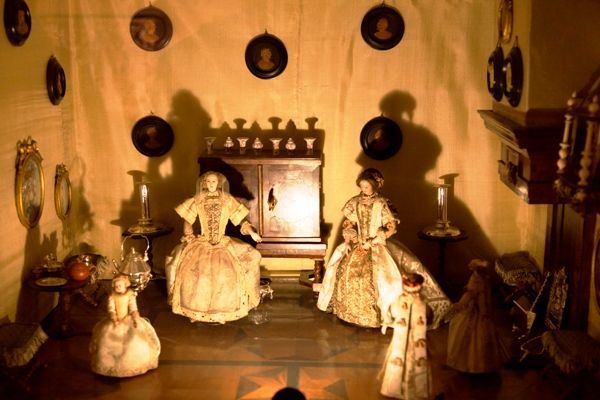
One of the famed dollhouse rooms
There are blockbuster attractions in Amsterdam. The Rijksmuseum is showcasing 400 of its best pieces while it is closed for renovation. It will reopen in spring 2013. In the meantime, it is enjoying the same number of visitors as before the renovation, about one million per year. A curator said — tongue in cheek — that he wondered why the entire museum needed to reopen since the number of visitors was the same and fewer guards were needed, thereby costing less for the Rijksmuseum.
The Van Gogh Museum, nearby, is closed as of September, but exhibiting at the Amsterdam Hermitage Museum in the interim, which is walking distance away. Then, there is Rembrandt’s home and the Anne Frank house, plus many more museums depending on taste and time.
Basel, the destination
Just as I opted out of Viking's pre-trip, I chose to make
my own arrangements when the cruise ended in Basel, Switzerland. The Viking post tour was at Lake Lucerne, while we chose to stay in Basel for two extra days.
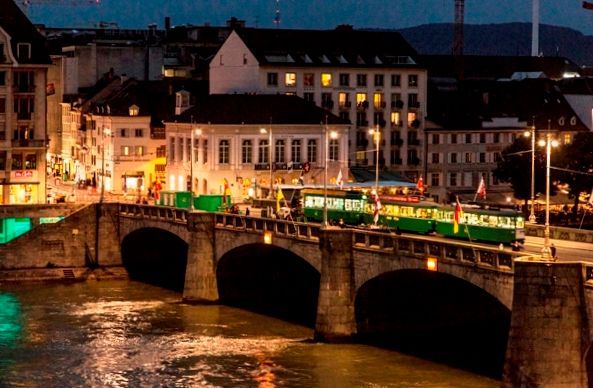
One of the many bridges and trams in the city
Basel is small and easy to get around and seems safe like Amsterdam. Not knowing how much recuperation we would need from the cruise (turns out we didn’t need any), we treated ourselves to a stay at the premier hotel in the city, the Trois Rois.
The day we debarked the ship we were able to see the fine arts museum, the Kunstmuseum. It was within easy walking distance of our hotel which was located in the old city as well as the museum.
Upon entering on the ground floor of the Kunstmuseum, I thought we had gone to the wrong place. The ultra-modern art through the double
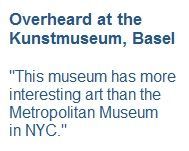
glass door directly in front of the entrance is a trick to the brain. It suggested that the museum was displaying modern art. The upper floors, however, disabused us of this idea. They were filled with treasures, many of which are rarely, if ever, seen in the U.S.
For example, the Marc Chagall room had four large oils of elderly Jewish men, one in red, another in green and two in splashes of white and yellow — very dramatic. The early Flemish art was also outstanding, with many Lucas Cranach pieces that seemed far superior to what I had seen in other museums. My only conclusion would be that his best masterpieces and many of the others in the museum are nearer home than they would be in the United States and elsewhere further afield (as many would argue they should be).
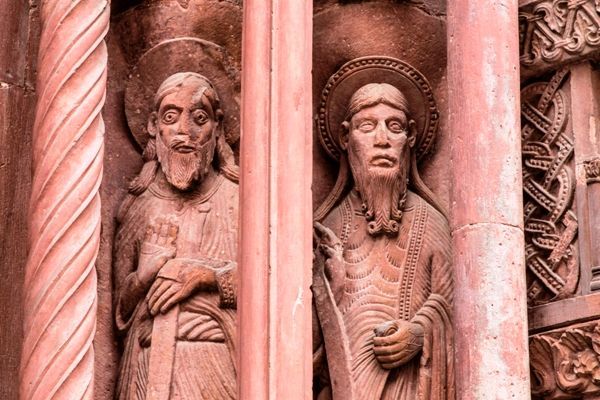
Elegant carvings like this embellish the church
On the way to the Kunstmuseum we walked past the Basel Minister (Basler Münster) designated by Switzerland as a heritage site of national significance. There were other museums on our way, too, such as the natural history and ethnology museums. In all, the compact ancient Basel area has about 13 museums, a plethora of riches for those so inclined.
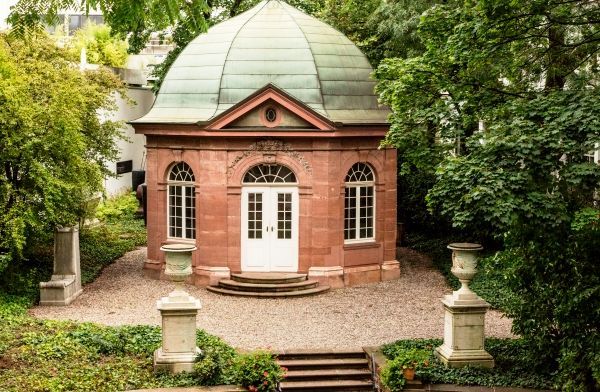
The gazebo behind the living culture section of the Historical Museum, one of the museums four sections
After the Kunstmuseum we went to the living culture part of the Historical Museum called the Haus Zum Kirschgarten (some of the site can be translated into English, but other pages remain in German). This is one of the four sections of the Historical Museum, the others being the Coach and Sleigh, the Musical Instrument and Intersect Museum highlighting Swiss, French and German cultural interactions.
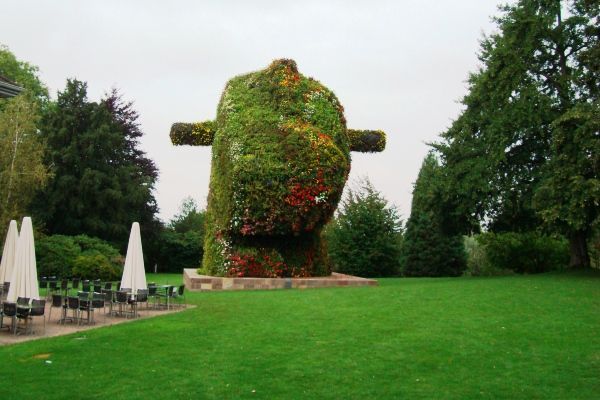
Jeff Koon’s Split Rocker topiary
The next day we went further afield, going first to the Foundation Beyeler. An exhibit by Jeff Koon had just closed, but there were still vestiges. Split-Rocker, his creative floral topiary, was on the lawn. Others located inside included vases for flowers in animal forms, which I could easily imagine on my own doorstep welcoming visitors.
The permanent gallery space within the Foundation Beyeler is so generous that its modern art is shown to best advantage and can take the breath away of even a hardcore modern art adversary. One rarely sees art in a large space such as it must have been intended to occupy.
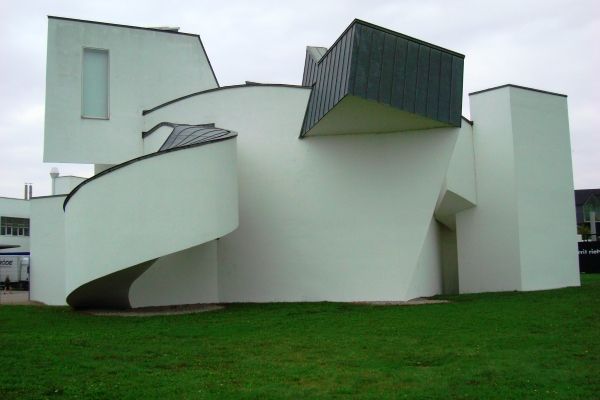
The Frank Gehry designed building at the Vitra Design Museum
The Vitra Design Museum — just a 6 tram and 55 bus away from the Trois Rois — is located in Germany, not Switzerland. It is a complete contrast to the old Basel city center. We learned on a two-hour English speaking guided tour that the Vitra Company started the museum to showcase its products in the late 1980s.
In spite of its commercial aspect, there is art to be found at Vitra both architecturally outside and in the interiors. Jacques Herzog and Pierre de Meuron are responsible for the 2010 main structure, which they achieved by mounding 12 individual houses together. Continuity is provided for the whole with a uniform roof that is gable in character.
There is also a 1989 Frank Gehry-designed building that holds exhibits not as commercially driven as the main structure. We saw the work of Gerritt Rietveld, a Dutch designer said to be one of the most important of the 20th century.
Zaha Hadid was the architect for the old fire station in 1993 and Tadao Ando designed the conference pavilion the same year. The other buildings in the large complex, including the factories, were planned by equally important architects. The airstream, which sold snacks and drinks just outside the main Herzog and de Meuron designed complex, was a nod to the U.S.
Summary
Both Amsterdam and Basel are small easy cities. Public transportation is excellent in each if walking is not an option (which usually it is). The sights are fabulous in both.
I should warn, however, that Basel is particularly expensive.
